The Shaper faction in Netrunner are those runners who hack into corporations not as part of some grand message or to make a profit, but do so just to see if they can. They are the ones who tinker with home-made consoles and hand-crafted programs. They are the ones capable of taking old pieces of various devices and transforming them into something new. As such, the focus on them in Creation and Control adds new possibilities to the Shaper archetype.
Rielle "Kit" Peddler: Transhuman
Kit is the one runner in this set to get a short excerpt in the insert for this set. Her encounter with a piece of ice is comprised of a series of verbal exchanges, resulting in the ice allowing her through due to its new desire to be more than it is. This ties into her ability. She gives the code gate subtype to the first piece of ice she encounters each turn, until the run ends. As such, she can break into any server protected by a single piece of ice as long as she has a decoder. This will force the corporation to not only protect servers with additional ice, but they will have to carefully position ice as well, as she will benefit if the first piece of ice she comes across is not already a code gate. To offset this powerful ability, her influence is only 10, meaning you will have to make some careful choices about what you bring in.
Pair cards: decoders, Tinkering, Paintbrush
The Professor: Keeper of Knowledge
The Professor was working on a massive project for Haas-Bioroid. When he learned what the megacorporation intended to do with the research, he sabotaged his own project to keep it from falling into their grasp. As a result, the corporation used its influence to remove him from his prestigious research position, forcing him to teach multiple classes to undergraduate students every day. As such, The Professor has only 1 point of influence. But, to make up for that, the first copy of each program in his deck does not count against his influence. So he is capable of using any program from any faction, as long as he only has one copy. Also, because influence can not be lowered below 1, he can use cards from the NAPD Most Wanted List without it affecting his choice of influence cards greatly. Still, you do not see The Professor played much, as it tends to be difficult to build a decent deck around programs alone.
Pair cards: programs, Sahasrara
Exile: Streethawk
Nobody is exactly sure who Exile is. Rumors persist that he is a disgraced ristie, or some self-taught technological prodigy. Still, he is the best at taking junk and re-configuring it to his needs. His ability gives him a card draw whenever he installs a program from his discard pile. Before the NAPD Most Wanted List was implemented, this was very powerful, as the Street Chess deck proved. Now it is somewhat harder, due to the fact that Clone Chip drains influence. Still, there are some new cards that can be installed from the discard pile, so perhaps Exile may be primed for a comeback soon.
Pair cards: Test Run, Retrieval Run, Scavenge, Pawn, Paperclip, Black Orchestra, MKUltra
Escher
A very interesting card. By making a successful run on HQ, you are allowed to rearrange all of the ice the corporation has installed, as long as the number of ice protecting each server with ice remains the same. So you could move ice around to make it cheaper for you to break into specific servers. Or if you are playing as Rielle "Kit" Peddler: Transhuman, you could make it so servers are mostly code gates, except for the first piece of ice on them, or make a server all code gates, making it easier to break in with fewer icebreakers. Another possibility is you could move unrezzed ice off of the corporation's scoring server, making it easier to break in without a nasty surprise. Ultimately, it is up to you how to set up your opponent's defenses, at least until they change them again.
Trivia: The card's name is in reference to M.C. Escher, the graphic designer known primarily for his depictions of impossible objects, tessellating patterns and bizarre perspectives.
Pair cards: PrePaid Voice PAD, Public Terminal
Exploratory Romp
Suppose your opponent installs a card in the open and advances it twice on their turn. Is it a trap or are they trying to sneak an agenda past you? Without some way to expose the card, the only way to find out is to risk the danger, unless you have this card. By playing this, if you make a successful run, then you can remove up to 3 advancement tokens from a single card in or protecting that server. So if it is in the open, you can run it again and take the agenda or disarm the trap. Or you could use this card to take tokens off of a piece of ice on the server, making it cheaper to run on the server in the future. This card is not commonly used, as people generally tend to either run cards with expose effects or just over draw cards to try and avoid damage. Still, this could disrupt the corporation's plans for a turn.
Pair cards: PrePaid Voice PAD, Public Terminal
Freelance Coding Contract
Shapers have the most card draw in their faction. But if you overdraw, you may be forced to discard cards you want to keep at the end of your turn. So if you have to discard some cards, why not make some money off of it? This card allows you to discard up to 5 programs from your hand, and gives you 2 credits for each program discarded. That means you can get up to 10 credits from this card, although it is more spread among the cards you discarded as well. Of course, to get the most benefit out of this card, you will have to fill your deck with programs, and you will have to be able to draw them, and you must have this card in your hand to play as well.
Pair cards: Public Sympathy, Diesel, Quality Time, Game Day, Beach Party
Scavenge
The possibilities presented by this card are myriad. Basically, you get rid of a program you have now and install one from your hand or discard pile, reducing the cost of the new program by the cost of the old program. You may think that this is just a way to get a discount, but the better function is the possibility of resetting your icebreakers. Suppose you install a Femme Fatale to bypass a troublesome piece of ice, only for the corporation to trash that piece of ice. With this card, you could trash your Femme Fatale as part of the cost, then reinstall the Femme Fatale, choosing a new piece of ice to bypass. Or suppose you have used up all of the counters on your Imp. With this, you could trash your Imp and reinstall it, getting new counters in the process. Plus, since it counts as a new instance of Imp, you could use a counter on that turn, even if you spent a counter off of the previous Imp. Again, the possibilities are dependent on what programs you use in your deck.
Pair cards: Overmind, D4v1d, Cache, Cerberus "Cuj.0" H3, Cerberus "Rex" H2, Cerberus "Lady" H1
Levy AR Lab Access
Despite your best efforts, your deck may run out of cards. As the runner, that is not an automatic loss for you, but it could mean you will not survive taking damage for much longer. With this card, you can shuffle all of the cards in your discard pile and hand back into your deck and draw 5 new cards. This gives you another opportunity to go through your deck and reuse all of your cards. Having 1 in your deck is usually enough to extend the game to a point where you could win, although a second copy is not bad. Just watch out for corporations cards that remove cards from your discard pile, such as Chronos Project and Ark Lockdown.
Pair cards: Same Old Thing, PrePaid Voice PAD
Monolith
The most expensive console so far. For a whopping 18 credits, you only gain 3 memory, but when you do install this, you can install up to 3 programs from your hand, lowering the install cost of each program by 4 credits. So if you install 3 programs that cost 4 with this ability, you have effectively spent only 6 credits on this. Plus, while this is installed, you can discard a program from your hand to prevent a point of net or brain damage, making this one of the few ways to prevent brain damage. Of course, building up to the 18 credits can be a challenge, so if you are going to run this, you will need a solid economy.
Trivia: I suspect this console is supposed to belong to The Professor: Keeper of Knowledge, as his ability to include lots of programs seems to function with the ability to install those programs with this card.
Pair cards: Modded, Eureka!
Feedback Filter
If you recall Net Shield from the core set, you can see some similarity. While Net Shield can only prevent 1 point of net damage each turn, this can prevent any net damage you take, as long as you can pay the credits for it. But by trashing this card, you can prevent up to 2 points of brain damage, making this one of the few ways to prevent brain damage. If you think you are going to be consistently facing net and/or brain damage, and you can afford this, then this might be a decent choice for your deck.
Pair cards: Inside Man, Replicator
Clone Chip
The ability to install a program from your discard pile at practically any time is immensely powerful. You could install a Parasite in the middle of a run to destroy a piece of ice the corporation just rezzed, or you could install a Femme Fatale to bypass that piece of ice. You could install a Clot to stop the corporation from fast advancing out an agenda. You can get back a program the corporation destroyed, or something you had to get rid of earlier that you want now. In fact, this card's ability is so powerful it ended up on the NAPD Most Wanted List, so each copy you put of it into your deck will lower your maximum influence by 1, so you will have to make some hard choices about what else you bring into your deck. Still, losing 3 influence to bring 3 copies of this in may just make the difference in your deck.
Pair cards: Inside Man, Replicator
Omni-drive
You can sort of think of this as a more expensive version of Akamatsu Mem Chip. This can host a single program, as long as it requires 1 memory or less. Plus, this card comes with a recurring credit that can be used to pay for using the hosted program. Granted, this is not frequently used, probably because other memory solutions are cheaper. It could be a way to reduce the cost of some of your runs, if you can use it every turn.
Pair cards: Modded, Inside Man, Replicator
Atman
This icebreaker is what you make of it. Depending on how the corporation has distributed strength throughout their selection of ice, you could be able to break some or much of their ice very cheaply. Typically, you will see one copy installed at strength 0, one at strength 2, and one at strength 4, which allows you to break practically anything as long as you have some Datasucker counters as well. Still, be aware of the few pieces of ice that specifically prohibit AI icebreakers from interacting with them.
Trivia: Atman is a term in both Hinduism and Buddhism referring to the self or the soul.
Pair cards: Cyberfeeder, Datasucker, Mimic
Cloak
While it may seem that paying a credit to have a credit that can only be used to pay for using icebreakers and takes up a memory slot is not so good, it can actually be very useful. Since you get that credit every turn, it means you spend less from your credit pool to break into servers. Also of note, this program has the stealth subtype, which is important, as we are about to start encountering icebreakers that require stealth credits for use. As such, Cloak is quite good with those icebreakers. Just make sure to invest in some additional memory in your deck.
Trivia: This card is a reprint. In the Netrunner CCG, we have Invisibility, a program that is practically identical to Cloak, except it is free to install.
Pair cards: Dagger, BlacKat, Refractor, Switchblade, Mirror, Dai V, Houdini, Net Mercur, Blackstone, Fawkes
Dagger
And now we come to the first of those stealth dependent icebreakers. You have to spend 1 credit from a stealth source to increase the strength, but that one stealth credit is worth a massive 5 points of strength. That puts it into the range of most sentries with just the 1 credit. Of course, running this means you will want access to a decent amount of stealth credits, so you can deal with those sentries.
Pair cards: The Personal Touch, Cloak, Silencer, Ghost Runner, Net Mercur
Chakana
Somewhat interesting. With this in play, repeated runs on R&D will make it harder for the corporation to score out their agendas, and possibly shut down fast advance decks. Of course, you have to make at least 3 successful runs on R&D before this comes into effect. Plus, all that work is easily undone by the corporation purging virsuses. Still, if you have 3 of these in play you could increase the advancement requirement of all agendas by up to 3, meaning it would take a lot more resources and time for the corporation to score their agendas.
Trivia: Chakana, or the Incan Cross, is a stepped cross made up of an equal-armed cross indicating the cardinal directions on a compass and a superimposed square. Each element represents one of the layers of existence: Hana Pacha, being the realm of the gods, Kay Pacha, the realm of mortal men, and Uku or Uhrin Pacha, the realm of spirits of the dead. You can see this representation depicted in the artwork.
Pair cards: Déjà Vu, Cyberfeeder, Grimoire, Djinn, MemStrips
Cyber-Cypher
Remarkably cheap and with a decent strength to begin with, this is a very efficient decoder. Of course, there is a catch. When you install this card, you have to choose a server, and this card can only be used during runs on that server. Still, you are free to install additional copies, with each copy on a different server. Of course, the server has to exist when you install Cyber-Cypher, so you may want to wait until they start to set up their scoring server before you place one on a remote server.
Pair cards: Rielle "Kit" Peddler: Transhuman, Scavenge
Paricia
Sort of the Shaper equivalent of Scrubber, except that this card can only be used to trash assets and it takes up memory. On the upside, this card is free to install, as long as you have the memory for it. Plus, since this card is in a deluxe expansion, it will always be available, seeing as how Scrubber will rotate out with the first cycle rotation.
Trivia: A direct reprint. From Netrunner CCG, we have Poltergeist, which is exactly the same as Paricia in cost and effect. Also, Paricia was an Incan god who sent a flood to kill humans who did not show adequate respect.
Pair cards: Akamatsu Mem Chip
Self-modifying Code
Another program tutoring card for the Shaper faction. Free to install, although it does take up 2 memory. This sort of functions like Clone Chip, in that it allows you to install programs at any time, except that it costs 2 credits to use this, and the program has to be in your deck. Still, if you need the ability to pull a program out of your deck instantly, this is a decent way to do so.
Trivia: Another reprint. From Netrunner CCG, we have Self-Modifying Code, which is exactly the same, except it costs 2 to install.
Pair cards: all programs
Sahasrara
Installing this is not much of an immediate gain. It does give you 2 recurring credits which can be used for installing programs, so to make effective use of this, you need to be installing programs every turn. The catch is you can not spend those credits if the install would override Sahasrara. Still, this could save a lot of credits if you have the space to install this. Plus, when you no longer need it, you could possibly get rid of it for a benefit.
Trivia: Sahasrara is the crown chakra or seventh primary chakra. It is described as a thousand-petaled lotus. All other chakras originate from this one. Also, this is a reprint. From Netrunner CCG, we have Zetatech Software Installer, which has 2 credits for installing programs, but costs 0 to install, and the credits on it can be used during an install that overwrites the Installer.
Pair cards: all programs, Aesop's Pawnshop
Inti
This has some potential. It is free to install, which is always good. It starts with 1strength and breaks barrier subroutines for 1 credit. The drawback is that it costs 2 credits to give it 1 point of strength, although that persists for the duration of the run. Primarily, you will probably use this as a backup to your main fracter, although this can be decent for breaking very low strength barriers, such as Ice Wall, Paper Wall, and Wraparound.
Trivia: As the flavor text implies, Inti is generally considered to be the Incan sun god.
Pair cards: Datasucker, Self-modifying Code, Şifr
Professional Contacts
Similar to Magnum Opus in that you are getting 2 clicks worth of actions out of 1 click, only this card gives you a credit and a card. This can be fairly decent in early and mid game, although as it does not generate nearly as much cash as Magnum Opus, it should probably not be used as your primary economic engine, but used to augment your economy. Plus, if your deck runs out of cards and you have no recursion, then this card becomes pointless. As such, if you think you need credits and cards simultaneously, go for it. Otherwise, it might be better to use other cards.
Trivia: Yet another reprint. From Netrunner CCG, we have Silicon Saloon Franchise, which has the same effect, but costs 8 to install.
Pair cards: Hostage, Off-Campus Apartment, Career Fair
Borrowed Satellite
Kind of interesting. This card adds 1 to your link strength and increases your maximum hand size by 1. There are cheaper cards for either effect, so the main benefit of this card is combining them into one card. If you are going with a high link strength deck, this might be worth including alongside Rabbit Hole and Access to Globalsec. Plus, being able to hold onto extra cards means that the corporation might have to put extra effort into trying to flatline you.
Pair cards: Underworld Contact, Security Chip, Security Nexus, Globalsec Security Clearance, Jak Sinclair
Ice Analyzer
Similar to Compromised Employee in that you get credits whenever the corporation rezzes ice. Except in this case, those credits go onto ice analyzer and can only be used for installing programs. As such, to get good use out of this, you will want to force the corporation to rez their ice multiple times. The ability to derez ice is primarily in Criminal, so using this card might mean you will be spending influence either for those cards into Shaper, or by bringing this into a Criminal deck.
Pair cards: Emergency Shutdown, Crescentus, Golden, Peregrine, Saker
Dirty Laundry
Definitely a good card. This card gives you additional reward for making a successful run in the form of 5 credits after the run is completed. Of course, that means you can not use those credits during the run, but it can be a decent boost to your credit pool, helping replenish the credits you spent getting into the server in the first place, or to get back credits you spent on trashing an asset or upgrade.
Pair cards: Desperado, PrePaid Voice PAD, Public Terminal, Ken "Express" Tenma: Disappeared Clone, Always Be Running
Daily Casts
Sort of a combination between drip economy and burst economy. For 3 credits, you gain 8 credits paid out over 4 turns, for a net gain of 5 credits. Plus, you are gaining those credits without spending clicks, which means you have more clicks on your turn for actions such as installing cards or making runs. Of course, once those 4 turns are up, you have to trash this, unless you get rid of it for an extra credit.
Pair cards: Aesop's Pawnshop, Career Fair
Same Old Thing
When it comes to events, you generally only get to play them once for each copy in your deck, unless you have recursion such as Déjà Vu or Levy AR Lab Access. But with this card, you can play an event card that is in your discard pile. The catch is that is costs an extra click, but it can be worth it in order to use your events again.
Pair cards: all events
The Source
Quite an interesting card. It is unique, and at the point when released, the first neutral card with an influence cost. Of course, it costs influence mostly because of its powerful effect. While this is installed, the advancement requirement of all agendas is increased by 1. That means the corporation will not be able to fast advance most of their agendas. The downside is that as an additional cost to steal an agenda, you have to pay 3 credits. Also, if an agenda is scored or stolen, you trash The Source. So why would you want to put this card in a deck? Well, there are some ways to get around the negative effect it has on the runner, which means it is much more harmful to the corporation than it is to you. Still, including this in your deck requires some building around it.
Pair cards: Hostage, Fall Guy, Film Critic, Dr. Lovegood
And that does it for Creation and Control. Next time, we begin the Spin Cycle with Opening Moves.
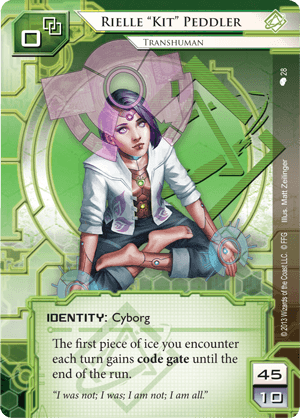
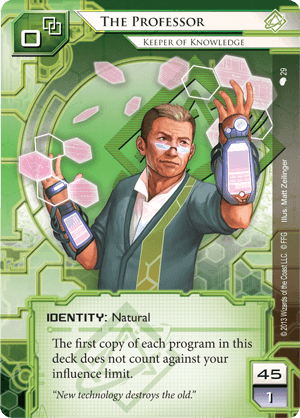

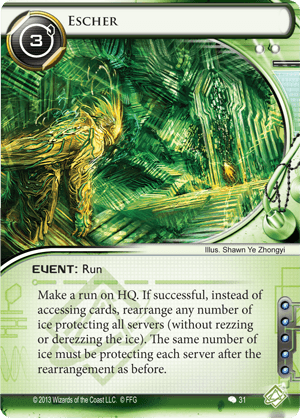

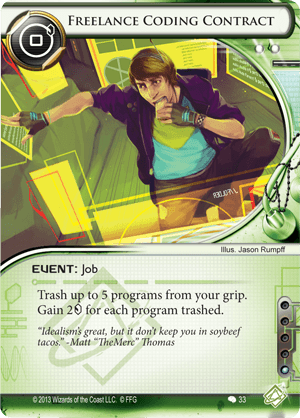
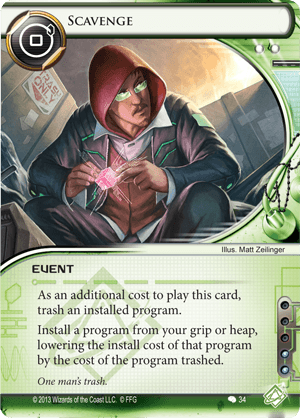
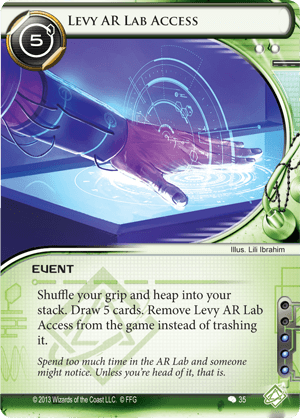

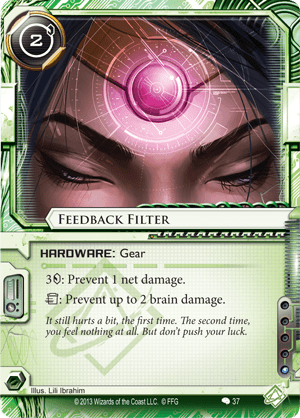
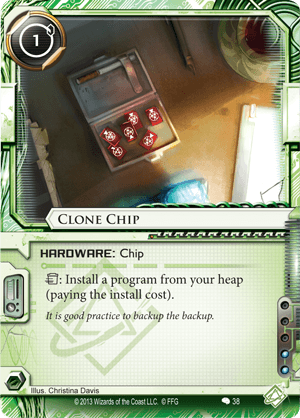
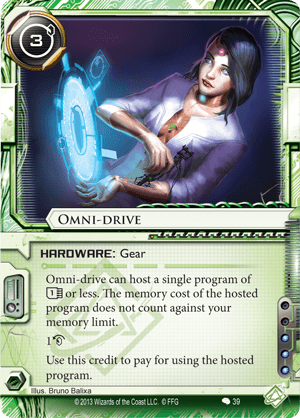
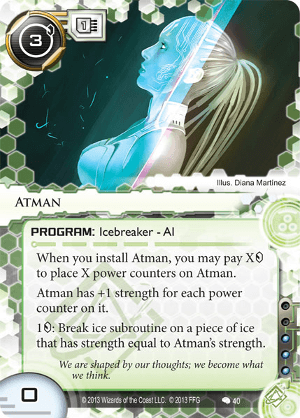
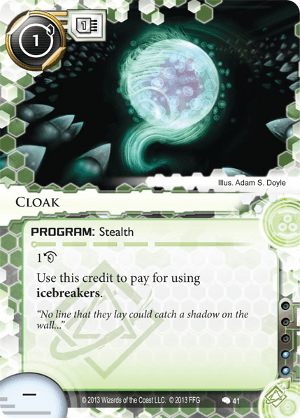
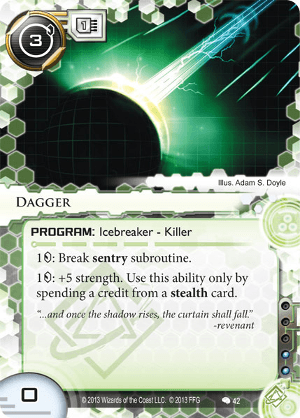
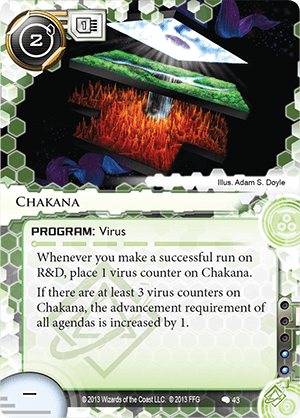
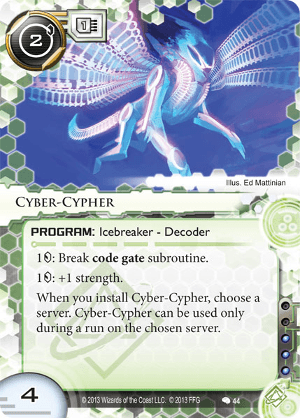

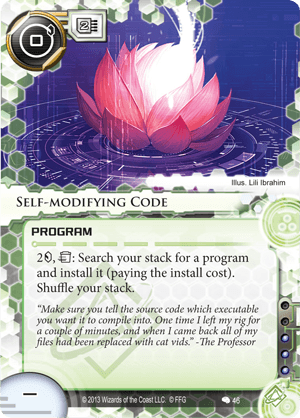
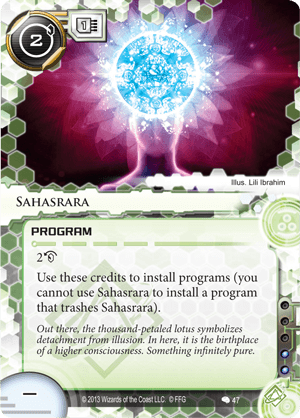
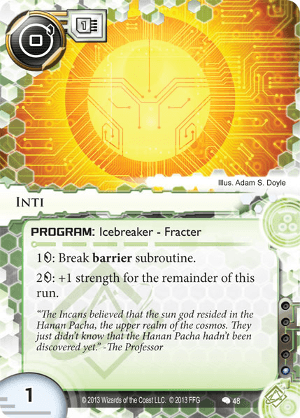
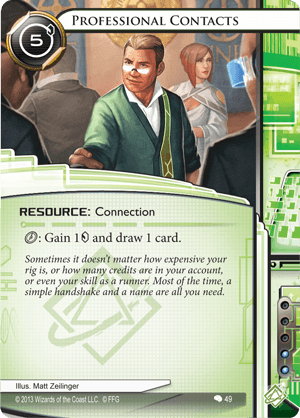
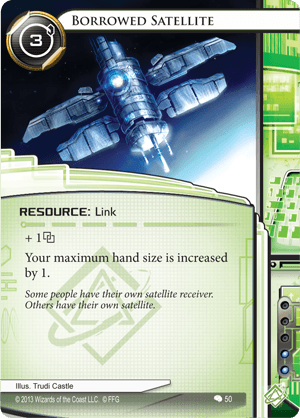
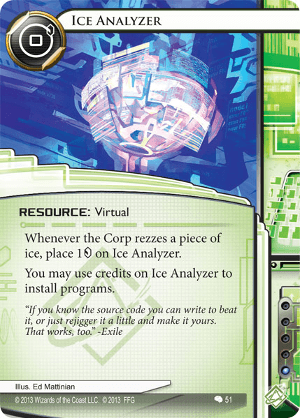
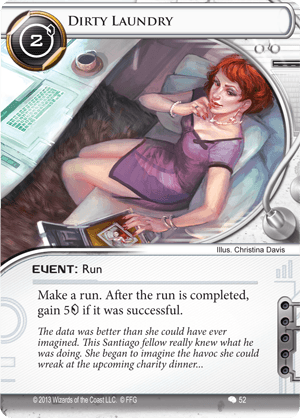
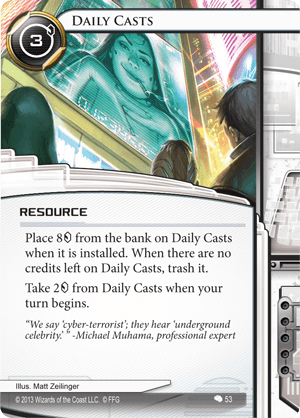
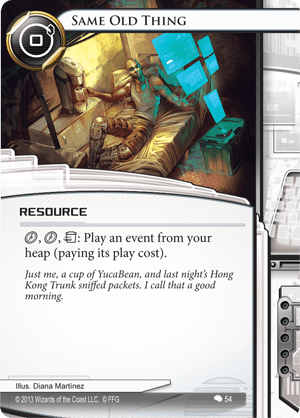
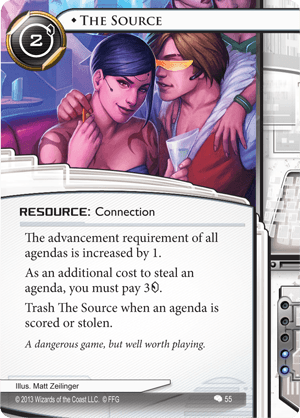
No comments:
Post a Comment